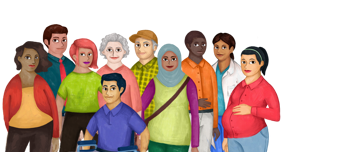
Credit: Getty Images.
All of Us is building a community of researchers—now more than 7,000 strong and counting—who are using the program’s health data to drive new health discoveries. Last month, All of Us held a virtual meeting with some of these researchers to hear preliminary findings from studies in progress and get researchers’ feedback on using the All of Us data in the Researcher Workbench. Attendees represented 25 research teams nationwide who had received supplemental funding from NIH to integrate All of Us data in their currently funded research projects. Their presentations covered a wide range of topics and offered an early glimpse into how All of Us may help shape precision medicine in the future.
Data Science Powered by All of Us
The All of Us dataset can help researchers develop complex models, powered by data from a diverse pool of more than 413,000 participants. Giorgio Quer, Ph.D., the director of artificial intelligence at the Scripps Research Translational Institute and a researcher for a National Center for Advancing Translational Sciences (NCATS) grant, studied Long COVID using data from All of Us and the National COVID Cohort Collaborative (N3C). He and his colleagues analyzed pre-COVID risk factors and post-COVID outcomes using electronic health records in both datasets and All of Us wearable sensor data from Fitbit devices. Using these combined data, they tested an algorithm that was developed for N3C to detect whether someone has Long COVID; they also investigated changes in wearable sensor data for individuals with Long COVID. In the long term, this research could lead to new ways to help monitor or treat Long COVID.
Embracing Racial Diversity
Many researchers are using the All of Us dataset to study health disparities because of the program’s diverse participant cohort. For instance, Eric Venner, Ph.D., director of clinical informatics at Baylor College of Medicine’s Human Genome Sequencing Center, is studying variants in the PALB2 gene, which have been shown to increase the risk for breast, ovarian, and pancreatic cancer. Venner’s group received support from the National Human Genome Research Institute to develop novel methods of genomic data analysis. The supplemental funding that they received allowed the team to expand their work to leverage the All of Us genomic data and include more diverse populations than previously planned. Using European ancestry as a reference standard, the researchers examined the frequency of PALB2 gene variants in all groups. They found that the prevalence of certain likely disease-causing mutations can differ depending on the person’s ancestry. This finding may enable improved diagnostics for people of non-European ancestry, which could help address health disparities in the future. “That would be impossible to find without a large and highly diverse cohort,” Venner said.
Similarly, cancer researcher Nicholas Woods, Ph.D., director of proteomics and systems biology at the University of Nebraska Medical Center’s Eppley Institute, is interested in the relationship between genetics and ethnicity among people who have pancreatic ductal adenocarcinoma (PDAC), a type of pancreatic cancer. His team received support from the National Institute of General Medical Sciences to develop therapies against molecules known to be associated with specific diseases. With the supplemental support to use All of Us data, they examined demographic information, survey responses, Fitbit data, and whole genome sequencing data. They created a cohort of 217 PDAC patients in the All of Us Researcher Workbench to examine how genes differed across the participants’ racial and ethnic identities. The researchers identified genetic variants that are associated with this highly lethal cancer and found different proteins depending on racial origin. These preliminary results have important implications for addressing health disparities, because Black people in the United States have significantly higher incidence of pancreatic cancer and shorter survival times than White and Latino/Hispanic people do. Based on this analysis, Woods believes, “All of Us is a powerful tool for the cancer research field.”
Looking at How Genomics and Environment Interact
Because participants share information about their neighborhoods with All of Us, researchers can study diseases by looking at the genome–environment relationship. Researchers at the Louisiana State University School of Public Health received funding from the National Cancer Institute to study triple-negative breast cancer. With supplemental support from All of Us, statistician Qingzhao Yu, Ph.D., used the Researcher Workbench to identify female All of Us participants who had been diagnosed with invasive breast cancer. Dr. Yu and her colleagues looked at information from All of Us and publicly available datasets to examine potential genetic biomakers to breast cancer outcomes and how the environment may relate to the gene expressions. They found that genomic information partially explained racial disparities in breast cancer survival. If confirmed, this finding could lead to novel therapies that aim at increasing survival among this vulnerable population in the future.
These projects are just the beginning of what can be done with All of Us data, and the work continues. Recently, All of Us announced a second phase of funding awards to support 26 new research projects involving All of Us data. Through these wide-ranging projects, researchers aim to develop new machine-learning tools, identify the genomic underpinnings of disease risk, and further explore the relationships among social, environmental, and genetic factors.
Explore NIH research funding opportunities.
This article appears in the October 2023 issue of All of Us Research Roundup. Subscribe to receive future issues of the bimonthly researcher newsletter.
View the full October edition of the All of Us Research Roundup here.
All of Us is a registered service mark of the U.S. Department of Health & Human Services (HHS).
